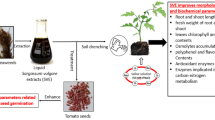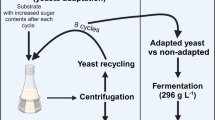Abstract
Vanadium pentoxide mainly used as catalyst in sulphuric acid, maleic anhydride and ceramics industry, is a pollutant watering redistributed around the environment. Research on biological influence of vanadium pentoxide has gained major importance because it exerts toxic effects on a wide variety of biological systems. In this work we intent to evaluate the effects of vanadium pentoxide ranging from 0 to 2 mM in culture media on a wine wild-type Saccharomyces cerevisiae from Alentejo region of Portugal. Our results show that 2.0 mM vanadium pentoxide in culture medium induced a significant increase of malonaldehyde level and Glutathione peroxidase activity, a slightly increase of Catalase A activity as well as a decrease of wet weight and mitochondrial NADH cit c reductase of S. cerevisiae UE-ME3. Also our results show that cycloheximide prevent cell death when cells grows 30 min in presence of 1.5 mM of vanadium pentoxide.






Similar content being viewed by others
Abbreviations
- V2O5 :
-
Vanadium pentoxide
- MDA:
-
Malonaldehyde
- CAT A:
-
Catalase peroxisomal
- GPx:
-
Glutathione peroxidase
- ROS:
-
Reactive oxygen species
References
Atlas RM (2006) Handbook of microbiological media for the examination of food, 2nd edn. CRC/Taylor & Francis, Boca Raton, p 403
Bakker BM, Overkamp KM, Maris AJA, Kotter P, Luttik MAH, Dijken JPD, Pronk JT (2001) Stoichiometry and compartmentation of NADH metabolism in Saccharomyces cerevisiae. FEMS Microbiol Rev 25:15–37
Bauer FF, Pretorius IS (2000) Yeast stress response and fermentation efficiency: how to survive the making of wine—a review. South African J Enol Vit 21:27–51
Beers RF, Sizer JW (1952) A spectrophotometric method for measuring the breakdown of hydrogen peroxide by catalase. J Biol Chem 195:133–138
Bode HP, Friebel C, Fuhrmann GF (1990) Vanadium uptake by yeast cells. Biochim Biophys Acta 1022:163–170
Cabiscol E, Piulats E, Echave P, Herrero E, Ros J (2000) Oxidative stress promotes specific protein damage in Saccharomyces cerevisiae. J Biol Chem 275:27393–27398
Chaudiere J, Wilhelmsen EC, Tappels AL (1984) Mechanism of selenium-glutathione peroxidase and its inhibition by mercaptocarboxylic acids and other mercaptans. J Biol Chem 259:1043–1050
Cohen G, Fessl F, Traczyk A, Rytka J, Ruis H (1985) Isolation of the catalase A gene of Saccharomyces cerevisiae by complementation of the ctal mutation. Mol Gen Genet 200:74–79
Cohen G, Rapatz W, Ruis H (1988) Sequence of the Saccharomyces cerevisiae CTA1 gene and amino acid sequence of catalase A derived from it. Eur J Biochem 176:159–163
Crichton PG, Affourtit C, Moore AL (2007) Identification of a mitochondrial alcohol dehydrogenase in Schizosaccharomyces pombe: new insights into energy metabolism. Biochem J 401:459–464
Davidson JF, Schiestl RH (2001) Mitochondrial respiratory electron carriers are involved in oxidative stress during heat stress in Saccharomyces cerevisiae. Mol Cell Biol 21:8483–8489
Esterbauer H (1993) Cytotoxicity and genotoxicity of lipid-oxidation products. Am J Clin Nutr 57:779S–786S
Esterbauer H, Schaur RJ, Zollner H (1991) Chemistry and biochemistry of 4-hydroxynonenal, malondialdehyde and related aldehydes. Free Rad Biol Med 11:81–128
Ferreira R, Alves-Pereira I, Magriço S, Ferraz-Franco C (2006) Comparative effects of NH4VO3 on detoxication enzymes and redox state of wine Saccharomyces. In: Collery P (ed) Metal ions in biology and medicine, vol 9. John Libbey Eurotext, Paris, pp 169–174
Fleet H, Heard GM (1992) Yeast-growth during fermentation. In: Fleet H (ed) Wine microbiology and biotechnology. Harwood Academic Publishers, Chur, pp 27–54
Flohé L, Gunzler WA (1984) Assay of glutathione peroxidase. Methods Enzymol 105:114–121
Halliwell B (1991) Reactive oxygen species in living systems: source, biochemistry, and role in human disease. Am J Med 91:3C-14S–3C-38S
Herrero E, Ros J, Belli G, Cabiscol E (2008) Redox control and oxidative stress in yeast cell. Biochim Biophys Acta 1780:1217–1235
Holme DJ, Peck H (1993) Enzymes. In: Holme DJ (ed) Analytical biochemistry, 2nd edn. John Wiley & Sons, New York, pp 261–318
Inoue Y, Matsuda T, Sugiyama KI, Izawa S, Kimura A (1999) Genetic analysis of glutathione peroxidase in oxidative stress response of Saccharomyces cerevisiae. J Biol Chem 274:27002–27009
Izawa S, Inoue Y, Kimura A (1995) Oxidative stress response in yeast: effect of glutathione on adaptation to hydrogen peroxide stress in Saccharomyces cerevisiae. FEBS Lett 368:73–76
Jault JM, Comte J, Gautheron DC, Dipietro A (1994) Preparation of highly phosphorylating mitochondria from the yeast Schizosaccharomyces pombe. J Bioenerg Biomembr 26:447–456
Kappus H (1987) A survey of chemicals inducing lipid peroxidation in biological systems. Chem Phys Lipids 45:105–115
Kitamura Y, Umemura T, Okazaki K, Kankil K, Imazawa T, Masegi T, Nishikawa A, Hirose M (2006) Enhancing effects of simultaneous treatment with sodium nitrite on 2-amino 3 methylimidazo[4,5-f]quinoline-induced rat liver, colon and Zymbal’s gland carcinogenesis after initiation with diethylnitrosamine and 1,2-dimethylhydrazine. Int J Cancer 118:2399–2404
Lazarow PB, Fujiki Y (1985) Biogenesis of peroxisomes. Annu Rev Cell Biol 1:489–530
Li W, Sun L, Liang Q, Wang J, Mo W, Zhou B (2006) Yeast AMID homologue Ndi1p displays respiration restricted apoptotic activity and is involved in chronological aging. Mol Biol Cell 17:1802–1811
Lock EA, Mitchell AM, Elcombe CR (1989) Biochemical mechanisms of induction of hepatic peroxisome proliferation. Annu Rev Pharmacol Toxicol 29:145–163
Lowry OH, Rosenbrough NJ, Farr L, Randall RJ (1951) Protein measure with de folin phenol reagent. J Biol Chem 193:265–275
Ludovico P, Rodrigues F, Almeida A, Silva MT, Barrientos A, Côrte-Real M (2002) Cytochrome c release and mitochondria involvement in programmed cell death induced by acetic acid in Saccharomyces cerevisiae. Mol Biol Cell 13:2598–2606
Ludovico P, Sansonetty F, Silva MT, Côrte-Real M (2003) Acetic acid induces a programmed cell death process in the food spoilage yeast Zygosaccharomyces bailii. FEMS yeast research 3:91–96
Luttik MA, Overkamp KM, Kotter P, Vries S, Dijken JP, Pronk JT (1998) The Saccharomyces cerevisiae NDE1 and NDE2 genes encode separate mitochondrial NADH dehydrogenases catalyzing the oxidation of cytosolic NADH. J Biol Chem 273:24529–24534
Madeo F, Fröhlich E, Ligr M, Grey M, Sigrist SJ, Wolf DH, Fröhlich KU (1999) Oxygen stress: a regulator of apoptosis in yeast. J Cell Biol 145:757–767
Madeo F, Engelhardt S, Herker E, Lehman N, Maldener C, Proksch A, Wissing S, Frohlich KU (2002) Apoptosis in yeast: a new model system with applications in cell biology and medicine. Curr Genet 41:2008–2216
Mannazzu I (2001) Vanadium detoxification and resistance in yeast: a minireview. Ann Microbiol 51:1–9
Maris AF, Assumpcao AL, Bonatto D, Brendel M, Henriques JA (2001) Diauxic shift-induced stress resistance against hydroperoxides in Saccharomyces cerevisiae is not an adaptive stress response and does not depend on functional mitochondria. Curr Genet 9:137–149
Matsuyama S, Xu Q, Velours J, Red JC (1998) Mitochondrial F0F1-ATPase proton-pump is required for function of pro-apoptotic protein Bax in yeast and mammalian cells. Mol Cell 1:327–336
Moore AL, Walters AJ, Thorpe J, Fricaud AC, Watts FZ (1992) Schizosaccharomyces pombe mitochondria: morphological, respiratory and protein import characteristics. Yeast 8:923–933
Nechay BR (1984) Mechanisms of action of vanadium. Annu Rev Pharmacol Toxicol 24:501–524
Overkamp KM, Baker BM, Kotter P, van Tuijl A, de Vries S, van Dijken JO, Pronk JT (2000) In vivo analysis of the mechanisms for oxidation of cytosolic NADH by Saccharomyces cerevisiae mitochondria. J Bacteriol 182:2823–2830
Penuelas J, Filella I (2002) Metal pollution in Spanish terrestrial ecosystems during twentieth century. Chemosphere 46:501–505
Petrova VY, Drescher D, Kujumdzieva AV, Schmitt MJ (2004) Dual targeting of yeast catalase A to peroxisomes and mitochondria. Biochem J 380:393–400
Pretorius IS (2000) Tailoring wine yeast for the new millennium: novel approaches to the ancient art of winemaking. Yeast 16:675–729
Querol A, Fernández-Espinar MT, Olmo M, Barrio E (2003) Adaptative evolution of wine yeast. Int J Food Microbiol 86:3–10
Sedensky MM, Morgan PG (2006) Mitochondrial respiration and reactive oxygen species in mitochondrial aging mutants. Exp Geront 41:237–245
Sies H, de Groot H (1992) Role of reactive oxygen species in cell toxicity. Toxicol Lett 64–65:547–551
Simon M, Adam G, Rapatz W, Spevak W, Ruis H (1991) The Saccharomyces cerevisiae ADRI gene is a positive regulator of transcription of genes encoding peroxisomal proteins. Mol Cel Bio 11:699–704
Skoneczny M, Chelstowska A, Rytka J (1988) Study of the conduction by fatty acids of catalase A and acyl-CoA oxidase. Eur J Biochem 174:297–302
Small WC, McAlister-Henn L (1998) Identification of a cytosolically directed NADH dehydrogenase in mitochondria of Saccharomyces cerevisiae. J Bacteriol 180:4051–4055
Sokal RR, Rohlf FJ (1997) Biometry. W. H. Freeman, New York
Steels EL, Learmonth RP, Watso K (1994) Stress tolerance and membrane lipid unsaturation in Saccharomyces cerevisiae grown aerobically or anaerobically. Microbiology 140:569–576
Tolbert NE (1981) Metabolic pathways in peroxisomes and glyoxysomes. Annu Rev Biochem 50:133–157
Turton HE, Dawes IW, Grant CM (1997) Saccharomyces cerevisiae exhibits a yAP-1-mediated adaptive response to malondialdehyde. J Bacteriol 179:1096–1101
Tzagoloff A (1971) Assembly of the mitochondrial membrane system. IV Role of mitochondrial and cytoplasmic protein synthesis in the biosynthesis of the rutamycin-sensitive adenosine triphosphate. J Biol Chem 246:3050–3056
Tzagoloff A, Akai A, Needleman RB (1975) Assembly of the mitochondrial membrane system. Characterization of nuclear mutants of Saccharomyces cerevisiae with defects in mitochondrial ATPase and respiratory enzymes. J Biol Chem 250:8228–8235
Uchiyama M, Mihara M (1978) Determination of malonaldehyde precursor in tissue by the thiobarbituric acid test. Anal Biochem 86:271–278
Veenhuis M, Mateblowski M, Kunau WH, Harder W (1987) Proliferation of microbodies in Saccharomyces cerevisiae. Yeast 3:77–84
Wang Y, Fang J, Leonard SS, Rao KM (2004) Cadmium inhibits the electron transfer chain and induces reactive oxygen species. Free Rad Biol Med 36:1434–1443
Willsky GR (1990) Vanadium in the biosphere. In: Chasteen ND (ed) Vanadium in biological systems. Kluwer, Netherlands, pp 1–24
Wissing S et al (2004) An AIF orthologue regulates apoptosis in yeast. J Cell Biol 166:969–974
Wu M, Xu LG, Li X, Zhai Z, Shu HB (2002) AMID, an apoptosisinducing factor-homologous mitochondrion-associated protein, induces caspase-independent apoptosis. J Biol Chem 277:25617–25623
Acknowledgments
We acknowledge to “Instituto de Ciências Agrárias e Ambientais Mediterrânicas” (ICAM) at University of Évora, Portugal, by financial support of this work. We thanks to Engº Paulo Laureano of the Laboratory of Enology of University of Évora for the yielding of the yeast strain.
Author information
Authors and Affiliations
Corresponding author
Rights and permissions
About this article
Cite this article
Rosado, T., Conim, A., Alves-Pereira, I. et al. Vanadium pentoxide effects on stress responses in wine Saccharomyces cerevisiae strain UE-ME3 . Ecotoxicology 18, 1116–1122 (2009). https://doi.org/10.1007/s10646-009-0363-9
Received:
Accepted:
Published:
Issue Date:
DOI: https://doi.org/10.1007/s10646-009-0363-9




